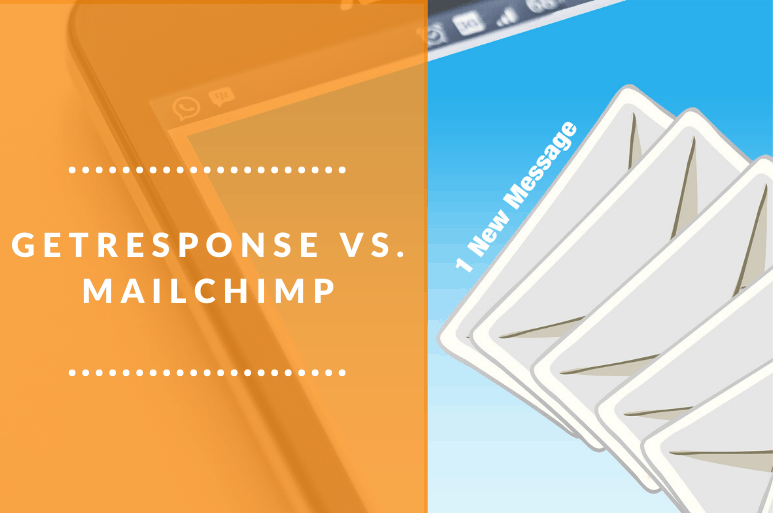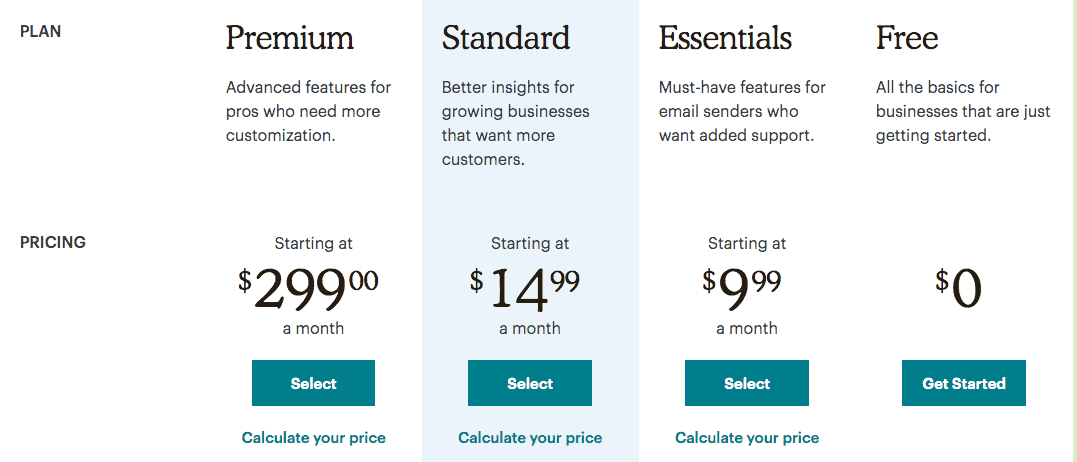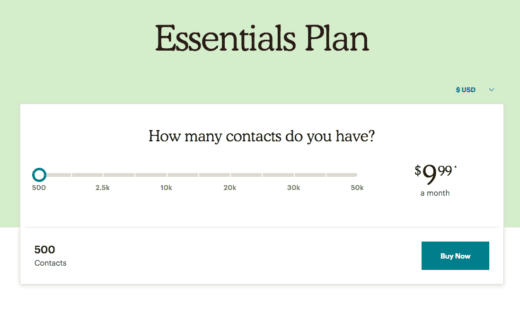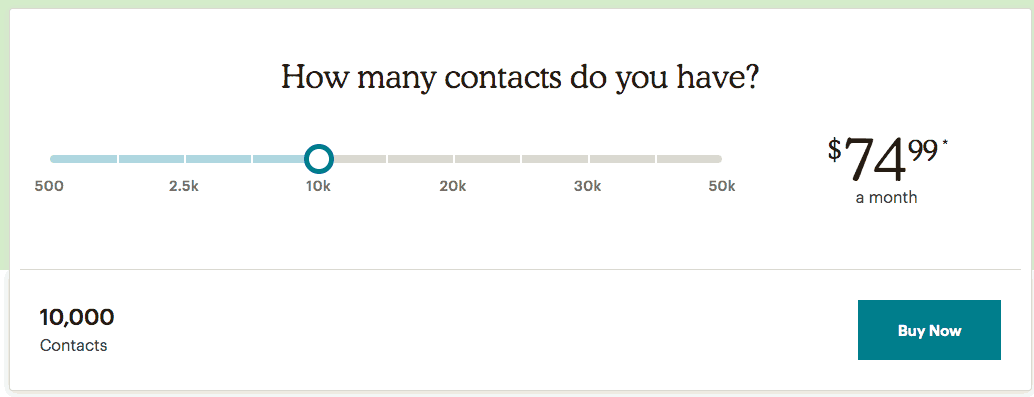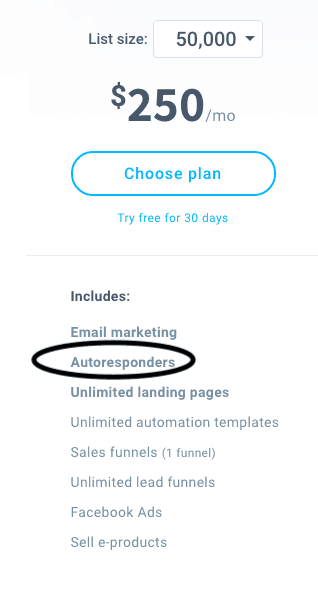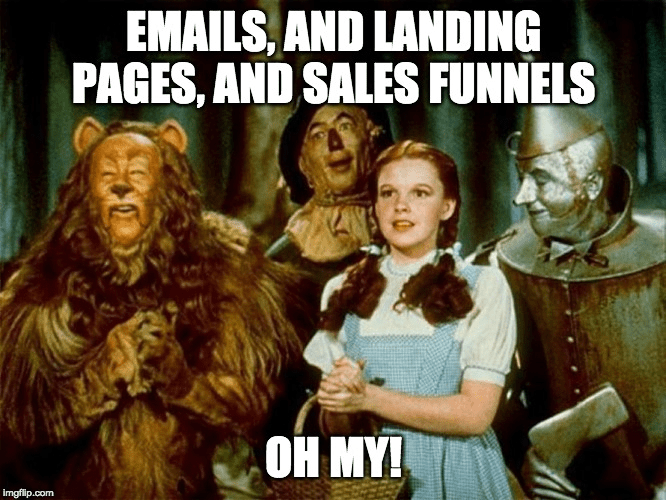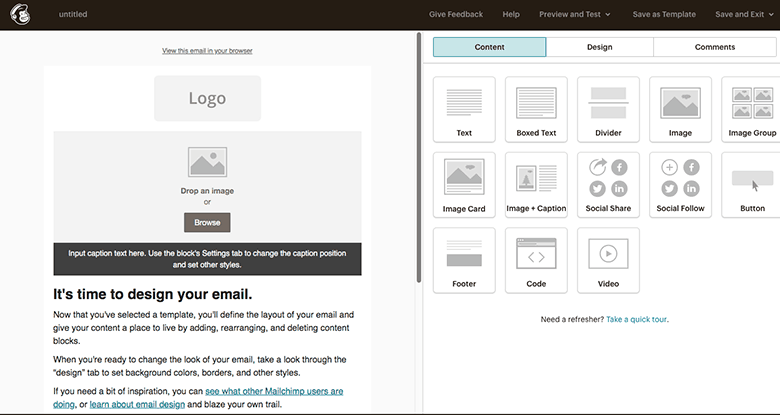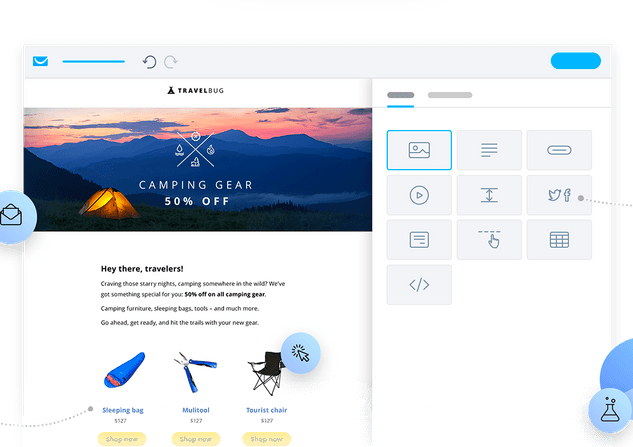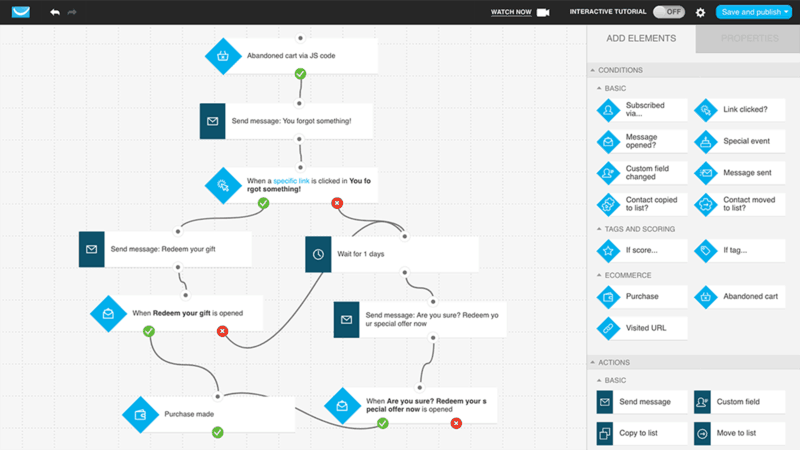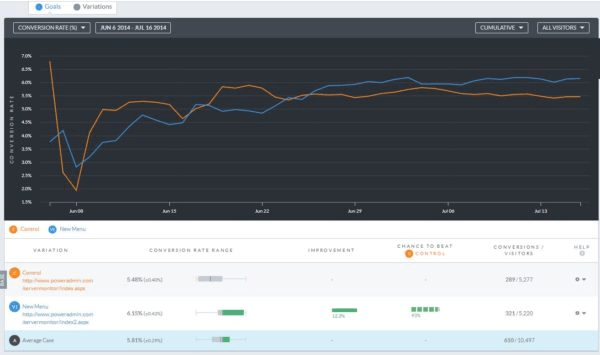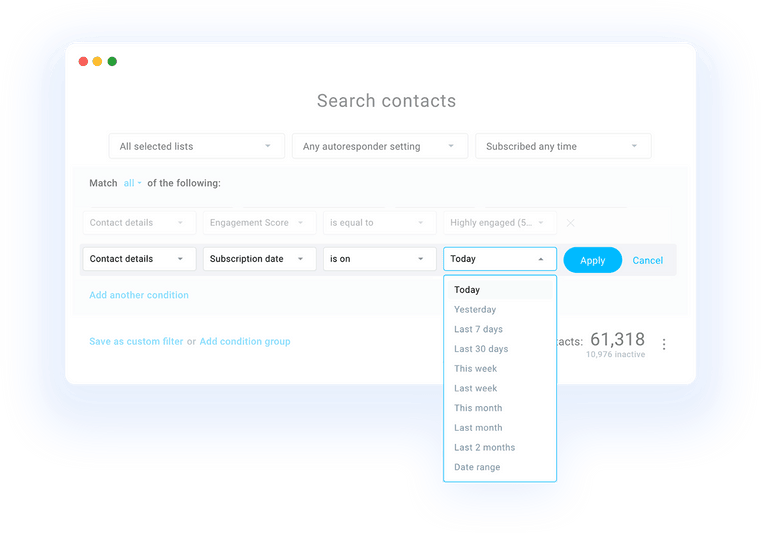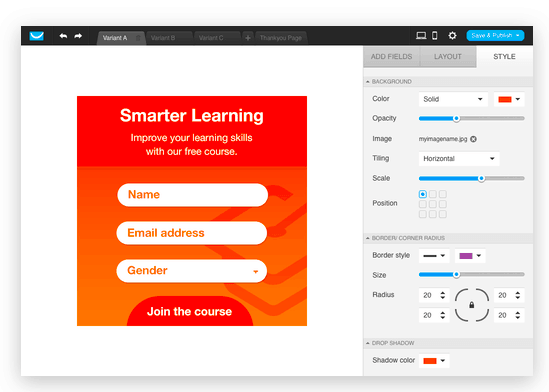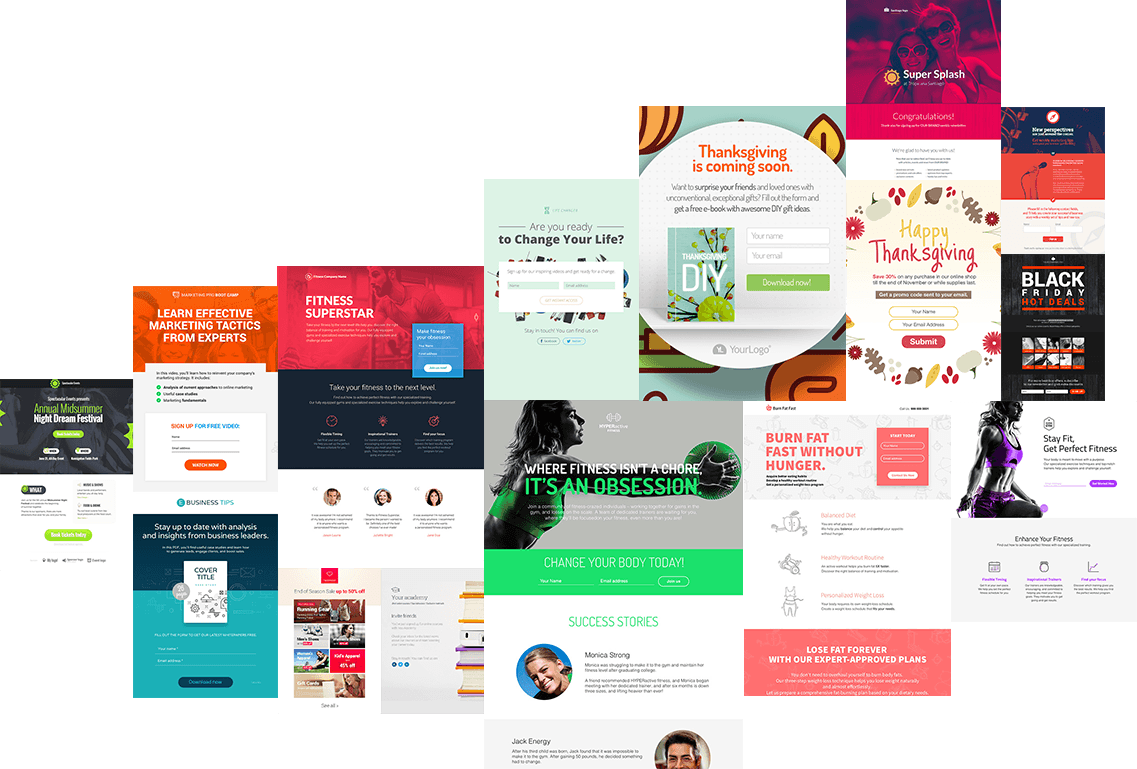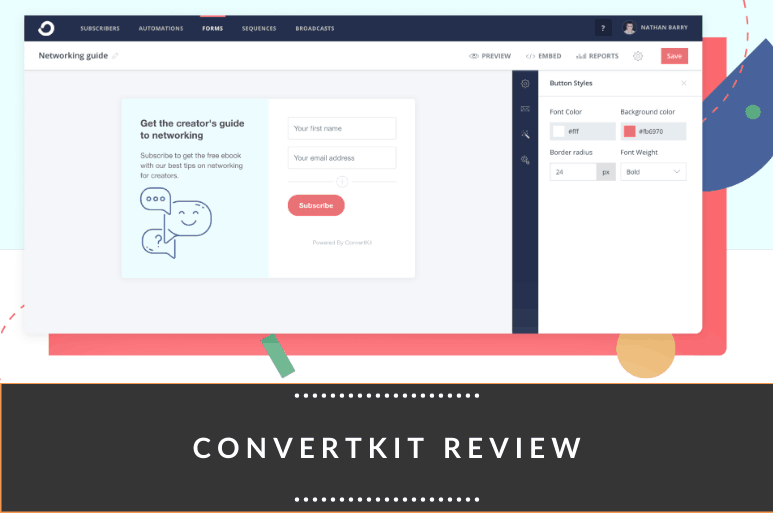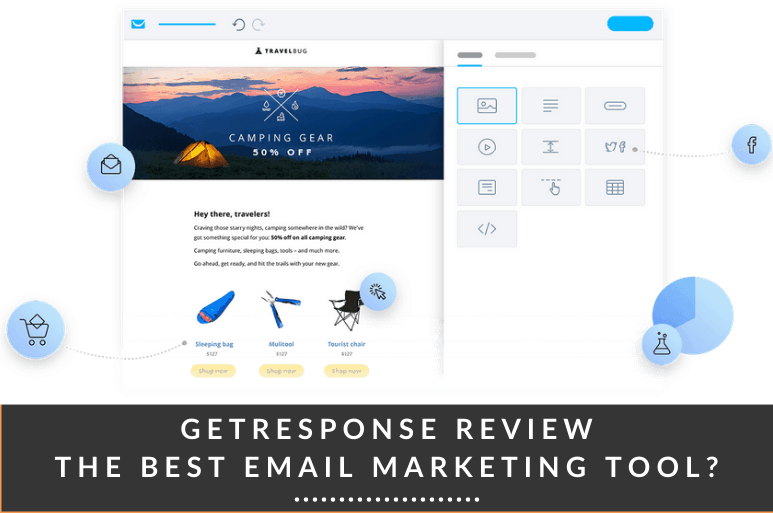Hey digital entrepreneurs, I’ve used MailChimp AND GetResponse for my business, and I can’t tell you how often my friends ask me which one is better.
Especially with the extreme criticism of MailChimp’s recent pricing changes (and stealth changes!) that have even loyal users looking for alternatives (I cover all that, don’t worry).
Instead of answering all of these annoying questions, I decided to make a GetResponse vs. MailChimp side-by-side review so you can make that decision for yourself.
There are so many different factors at play here. Are you a small business? How much experience do you have with email templates? What’s your budget? How many clients do you have? How much time do you have to invest in your marketing efforts?
If you’re a digital business owner, you’re going to love this guide and how it breaks down EVERYTHING each of these email marketing services can do to help grow your business.
Let’s go!
Get Response vs. MailChimp: What’s GetResponse? And Who is a MailChimp?
Let’s get the basics out of the way first. These are super important, especially if you haven’t used either platform before. There’s a HUGE difference between these platforms, even with MailChimp’s recent “pivot.”
What is MailChimp?
MailChimp is an email marketing automation platform founded in 2001. Even if you've had zero exposure to basic email marketing, you're still likely to recognize the logo.
MailChimp is basically the New England Patriots and New York Yankees of the industry: storied, successful, LOVED by so many, yet hated by so many more. But just like those franchises, MailChimp keeps winning and keeps getting bigger, stronger, and richer.
Love them or hate them, their software has helped pretty much every digital business grow fast—including my own. Pretty much every digital entrepreneur has used their “Freemium” plan to get their feet wet in the world of email marketing.
Until recently, I’d have recommended this for EVERYONE (more on that later).
MailChimp features:
- Import an email list
- Email and newsletter templates
- Marketing automation tools
- List management (segments, groups, and tags)
- Email analytics: open-rate, click-throughs, forwards, etc.
- Branding design tools
- Social media marketing features
MailChimp has pivoted recently and tried to expand on its features. Think of it like your favorite team tying to switch sports. It’s caused a lot of loyal fans to question their fandom. Their email marketing service is still great though.
What is GetResponse?
GetResponse is a full marketing platform used by over 350,000 customers in 183 countries to unleash their marketing through email automation, landing pages, and sales funnel building.
Basically, SHE’S A BEAST!
The main difference between GetResponse and MailChimp is that MailChimp is an email marketing platform/service masquerading as a full-service marketing platform.
GetResponse is the opposite: a full-service tool for growing your audience, promoting services, and selling products that happens to include all the features you need for email marketing.
The GetResponse suite of tools includes:
- Responsive email templates
- Campaign funnel templates
- High-converting landing page builder
- eCommerce store creation
- Social marketing features to drive more traffic
- Webinars
Theoretically, you can build a store, market to an email list, create landing pages, and drive traffic to those pages all through one dashboard.

Want to learn more? We've also got a full-on review of GetResponse for those interested.
OK, We Get It! GetResponse is the Greatest Tool on Earth. So Why Even Continue This Review?
Good question.
A huge mistake I see new entrepreneurs making is investing a lot of money in tools they don’t need. You know how sometimes you order 2 large pizzas for yourself for no reason only for the other one to sit in the fridge and go bad?
Don’t let your eyes get bigger than your business’ stomach. Yeah, GetResponse is awesome, but MailChimp is good too. It all depends on your needs.
Here’s how I’d go about making that decision: First, compare pricing based on my reviews and see what your budget is. From there, go to the features and see how they stack up side by side.
Finally, check out some of the email marketing alternatives I’ve included at the end. You might be able to pay nothing and still get what you need!
OK, let’s start talkin’ dollars.
GetResponse VS MailChimp: Pricing
MailChimp and GetResponse’s subscription plans are totally different. And this is where the controversy starts.
MailChimp was always known as the cheaper, beginner-friendly email marketing platform. It still is…kind of. But there are some sneaky charges that begin to add up and cause a bunch of headaches.
On the surface, GetResponse looks WAY more expensive, but as you dig deeper, you’ll find that it’s 100% worth it if you have the volume.
Pricing Plan Comparison
MailChimp’s pricing comes in 4 plans:
- FREE PLAN
- Essentials: $9.99
- Standard: $14.99
- Premium: $299
GetResponse is a tad different…
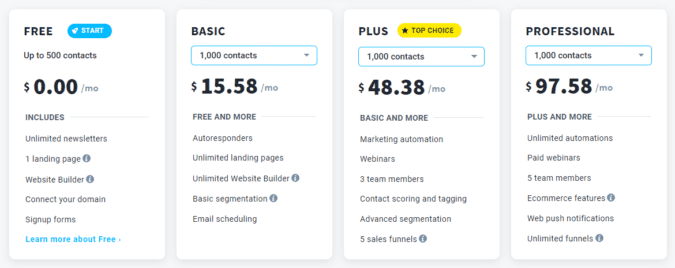
If your lists are only 1,000 subscribers (which isn’t many), your prices are:
- Free plan: Er… free.
- Basic: $15.58
- Plus: $48.38
- Professional: $97.58
MailChimp’s Free for Life Plan
This a quick win for MailChimp in my opinion. As I said, this is where I got my start.
MailChimp's forever free plan gives you access to:
- One audience (very controversial now)
- Basic templates
- 1-click email automation feature
- Basic CRM
For a small business or solopreneur just starting out, it’s fine. You’ll outgrow it quickly, though.
MailChimp Pricing Controversy: Why Are Loyal Fans Leaving?
MailChimp has made some sweeping changes recently that have devoted users (myself included) leaving the service.
Here’s the rundown:
MailChimp Sending Limits
Before, you could send unlimited emails to your lists. This was a huge positive for MailChimp, and it attracted tens of thousands of new customers.
Now, they have set limits in an attempt to force users to upgrade. It makes dollar and cents but doesn’t make common sense. It’s alienating a lot of users and hurting their reputation. The limits now are:
- Free plan: 10,000
- Essentials: 500,000
- Standard: 2 million
- Premium: 3 million
This looks like a lot, and most entrepreneurs won’t pass those limits. However, there are other hidden costs, too.
Pay By Audiences
MailChimp used to charge solely based on subscriber count. That’s fairly standard. No big deal.
Now, they charge by a new metric: audiences. And your audiences also include unsubscribed emails! So, even if someone in your list has unsubscribed, they are still counted in your audience.
While the plans may look cheaper on the surface, the more subscribers you have, the higher your price becomes. MailChimp may advertise $9.99 for the Essential plan, but look what happens when you grow:
Oh, $10! That’s nice!
Wait, $74.99? WHAT?!
In fairness, GetResponse's prices increase too, but it’s not as drastic. And, you get so much more with GetResponse compared to MailChimp. Plus, you get some features with GetResponse at lower tiers that you don’t get with MailChimp till you dish out $300 or more.
Comparing MailChimp Essential Plan vs. GetResponse Basic (And a Few Other Odds and Ends)
The two cheapest options for GetResponse and MailChimp are totally different.
Which is the best? It really depends on what you need.
GetResponse is actually cheaper if you have 50,000 subscribers or less. You’ll save about $9 a month (SCORE!).
That, and you get a lot more than the “Essential” MailChimp plan (including my favorite autoresponder feature).
SWEET!
It’s that vs THIS:
Less money and better features. That’s a big plus for GetResponse.
NOTE: MailChimp lets you get in the game for cheaper if you’re absolutely strapped for cash. Obviously there’s the free plan, but the “Essentials” plan allows you have up to 500 subs for $9.99.
What Really Irks Me About MailChimp Pricing
I mentioned it before but I have to say it again. Even if MailChimp might seem like it’s the same price or even cheaper at higher levels (e.g. their Standard plan with 50k contacts costs as much as GetResponse’s Plus plan), you’ll notice a big issue.
When GetResponse says 50,000, they mean 50,000. MailChimp counts UNSUBSCRIBED emails to your subscriber counts. That’s BS, in my opinion. So, you’ll notice your plan drying up quickly, forcing you to upgrade (and spend more)
Round 1: Pricing – Winner: GetResponse for fair, transparent pricing with the most features. MailChimp is fine for beginners that need something for free. Other than that, GetResponse wins.
Let’s see how their features stack up.
GetResponse vs. MailChimp: Features Comparison
Saying these two email marketing tools are robust in features is an understatement.
That’s actually a bad thing for most newbies. Where do you even start?
Email templates? Landing page builder? Sales funnels?
Arghhh!!!
I’m gonna break down the most important features here. I’d pay special attention to usability and templates since you’re probably new to this (sorry if you’re not and I triggered you).
Ease-Of-Use/UX
MailChimp User Experience
MailChimp’s visual drag-and-drop editor lets even the least techy people design a beautiful, professional email or newsletter with 0 coding experience.
Check out how easy the drag-and-drop interface is:
Drag what you want from the right side and drop it into a predetermined widget on the left. It doesn’t get any easier.
One thing you’ll notice right away with MailChimp is how breathable it is: white space, big fonts, open menus. There’s almost no clutter, it’s super easy to navigate, and there’s no avalanche of buttons hitting you in the face. This definitely passes the “can my grandma do this?” test.
I have to admit, once you get out of creating emails, things get a little dicier. I’ll get to that in a bit.
GetResponse User Experience
I love GetResponse’s drag-and drop-email editor. It’s modern, sleek, and easy on the eyes:
They claim to be “the easiest email marketing tool,” and they’re probably right. You can bulk load emails into a list in a few clicks, choose elements from the menu and easily add them to the email. There even some quick action buttons for executing the most common actions:
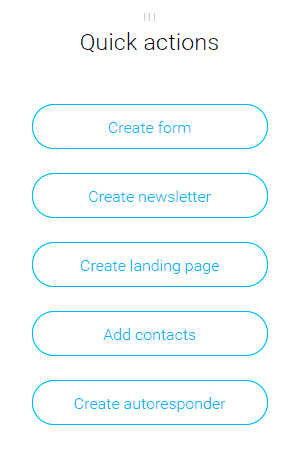
Pretty sweet. But unlike MailChimp, GetResponse uses more traditional dropdown menus, which I’m not a big fan of.
Round 2: UX – Winner: DRAW
I want to give this to GetResponse since it’s so easy to build multiple campaigns with their quick action buttons and their drag-and-drop UX is so kickass. But, when it comes to emails, MailChimp is so easy it’s stupid. I couldn’t make a decision here. One is easier in the big picture and one is easier for creating quick emails.
Autoresponders
OK, next up is a SUPER IMPORTANT email marketing feature that often gets overlooked. Learning how to use autoresponders to nurture my email list rather than bombard them with useless emails helped me scale my business fast.
In fact, this might be the most important part of email marketing. GetResponse and MailChimp both have great autoresponder features, but there’s a big catch with MailChimp that ticks me off.
What Are Autoresponders?
Autoresponders are messages sent to your email list at preset intervals or according to certain “triggers.” It could be:
- When someone signs up for a service
- After a week
- After 3 weeks
I’m assuming you have a decent grasp of time at this point, so let’s move on.
Imagine you get a new email signup and you send them a 15% new-customer discount. They notice it but quickly forget. With an autoresponder, you can trigger a new email to be sent to them in one week reminding them they have to use their coupon NOW BEFORE TIME RUNS OUT!
That’s a basic example, but you get the point. Once you set things up properly (not easy), your email subscribers will receive key messages automatically. Yes, that’s right. You do 0 work, and your entire email list gets important messages whenever you want.
This kind of “drip” email markting mentality helps slowly nurture customers rather than being all in their face and alienating them. It also saves you hours of time each day.
You aren’t limited to just time though. With email marketing tools, you can trigger emails based on actions like:
- Clicks
- Web page visits
- Forwarding
- Purchase
- Abandoned page/cart
So, if a customer abandons their cart, you can set that up to trigger an email saying “WAIT: here’s a discount! Get to it!”
Are you now seeing how awesome this is?
GetResponse vs MailChimp Autoresponders
Both GetResponse and Mailchimp have complete autoresponder functionality. You can trigger emails for pretty much everything. Including:
- Actions: Opens, clicks, forwarding…
- Purchase: Send em’ a thank you and offer a discount or beg for a review.
- Data change: If someone in your list changes their details.
- Time: Days, weeks, months later, etc.
In my opinion, both of these marketing automation tools are dead even in functionality. There’s not a lot of wiggle room here either. Get what I mean?
There are only so many ways you can trigger an email. They both have all of them.
But, they differ in two big ways that sway my opinion:
User Interface Comparison
When it comes to setting up automation workflows, GetResponse's user interface kicks MailChimp’s a**. No other way to put. Look at this thing!
You don’t even have to understand it to think it’s awesome. The visual editor makes customizing workflows insanely easy to construct even with 0 prior knowledge.
The MailChimp interface involves using templates. Those are fine, but they aren’t as cool as this!
MailChimp’s Basic Paid Plan Doesn't Include “Custom Workflows”
I love MailChimp’s Freemium plan. That’s how I got my start, and that’s how most others did too. Without it, I might not even be writing this.
But, they don’t have email autoresponders in the Essential or Freemium plan.
HOW?! This is like the most important thing!
I don’t really see a point in getting marketing automation software if you aren’t going to create “custom automated workflows” as MailChimp so eloquently tries to disguise its thievery. It’s like being betrayed by someone you trust.

If this was included in at least the bottom paid tier, I may have given this a draw. Now, I cannot.
Round 3: Autoresponders – Winner: GetResponse, and it’s not even close.
GetResponse vs MailChimp Templates Comparison
I think I speak for all frustrated entrepreneurs during pre-template times: templates are a GODSEND.
Before them, you either had to know how to code, hire some expensive designer, or send an email that looked like a clay tablet.
Now, both MailChimp and GetResponse have incredible, professional-looking templates that make your company look Fortune 500 instead of Fortune 500 BC.
GetResponse has templates to choose from for everything from landing pages to emails and newsletters. MailChimp has fewer templates but many are better looking.
My answer here might surprise you.
GetResponses Templates (500+)
GetResponse’s templates let you brand your company well from the beginning, even on a shoestring budget.
Once you log in, you’ll notice that their templates are neatly divided into categories. Does life get easier?
Are you a fitness buff? There’s a template for you (Or 25). Do you own a travel blog? GetResponse has a library of tested templates to increase signups.
MailChimp Templates
MailChimp doesn’t have the army of templates that GetResponse has. But gun to my head, I’d say theirs are actually better. Or at least more modern looking.
Another cool feature is that you can have MailChimp custom design one for you (for a fee…). Their templates are divided into categories as well but more along the lines of what you actually want them to accomplish. Do you want to sell something or announce something?
That’s how they do it. Actually, I kinda like it.
Notice how this is a bit more “modern-looking.”
Round 4: MailChimp: I might be nostalgic since I got my start with MailChimp, but I prefer their smaller army of templates. They get this one, but only slightly.
Creating and Sending Emails
Emails are probably the reason you came here, right?
Both MailChimp and GetResponse offer a drag-and-drop editor. They’re pretty much equal except for one key area. I’ll get to that in a bit.
What’s are the Key Differences Between MailChimp and GetResponse’s Editors?
While they’re both drag-and-drop, GetResponse’s is more flexible and robust.
But, that’s not necessarily a good thing. You can quickly create an email in MailChimp with 0 experience. GetResponse isn’t so easy.
Also, GetResponse can be a bit buggy. However, I really like the look of GetResponse’s editor.
Web Font Capabilities
Here’s where MailChimp steals one from GetResponse. The latter limits you to “safe” fonts like Arial or Times New Roman. MailChimp gives you a palette to paint with so you can go all Da Vinci up on that thing.
I think it’s definitely easier to create slick, cool-looking emails with MailChimp.
Mobile-Friendliness
The bullpen is coming in for GetResponse and the game is starting to slip away. MailChimp is “smallballing” their way to the lead right now by taking away another important factor here.
GetResponse allows you to preview mobile emails so you can see how they render very easily. But there have been a ton of ANNOYING bugs. Nothing’s worse than spending time on an email and seeing it not render in the Gmail app. GetResponse says a fix is coming soon, so keep your eyes open. If they fix that, this might go there way.
For now, MailChimp takes the lead.
Round 5: MailChimp: It’s easier to create decent-looking emails in MailChimp and they don’t have as many bugs. WARNING: Their drag-and-drop interface has bugs of its own, such as elements snapping in out of place. But not as many as GetRepsonse.
Analytics, Integrations, and Other Functions
The meat of GetResponse’s lineup is coming up. Something tells me they’re about to start hitting home runs….
I’m going to lump these together so this doesn’t become a War and Peace-level guide. The important information is brief anyway since GetResponse crushes hands-down.
A/B Testing
Split testing lets you test certain changes (like a different subject line) to an email/landing page to see which performs better: the original or the changed version.
The cool thing is, you don’t have to risk all of your traffic and money to get results. You can just test a smaller portion to see what the results are before expanding.
GetResponse laughs MailChimp off the field here. You can test more versions (5) and more variables including headlines, subject lines, form fields, and all that cool stuff.
MailChimp’s decent A/B testing features are only available on more expensive plans. GetResponse is cool enough to give them to you cheaper.
NOTE: In fairness, A/B testing is only needed with larger lists. If you’re just starting out, this isn’t a big deal. But trust me, my friend, it will be.
Segmentation
GetResponse smashes the ball out of the park with segmentation (*cue Babe Ruth calling his shot*).
GetResponse lets you send targeted emails to segmented lists, increasing your efficiency and profits. Essentially, despite working off just one list of subscribers, GetResponse's segmentation allows your to broadcast email campaigns as if you had multiple lists populated by different kinds of subscribers.
The benefit of being able to segment your subscribers into multiple lists is huge.
Here’s what I mean:
Say you have an email list called “new moms.” Aw, that’s sweet. The miracle of life.
With GetResponse, you can create segments for this audience – dividing them into 3 lists (for example):
- Moms of girls
- Moms of boys
- Moms of twins
In GetResponse, you can click which segments you want to send emails to and which ones you want to exclude. You wouldn’t send discount coupons for boys PJs to moms of girls, right?
MailChimp doesn’t give you nearly the same functionality in that department.
Reporting
I’m gonna be brief here. Both GetResponse and Mailchimp have comprehensive reporting, and I’m not willing to say one is flat-out better than the other.
They both give you an overview of all the important data plus cool bonuses (IP address, previously opened emails, etc.).
One cool feature that MailChimp has and GetResponse doesn’t is the “Engagement Stats” panel that shows you how often your subscribers open your emails.
GetResponse’s counterpunch to that is it can automatically create groups on precise user actions once an email is sent out. For example, GetResponse will automatically group people who didn’t open your email into one segment so you can send them an annoying reminder!
This one is a draw.
Signup Forms
Forms that allow you to capture email addresses are the backbone of building an email list. Embedding a signup form with both marketing apps is easy. You just grab a snippet of code, place it wherever you want, and you’re good to go.
GetResponse’s sign-up form editor (pictured) not only looks nice but it’s much better in my opinion. They also give you a bunch of sweet templates. Good for me since I can’t be bothered to do any designing of my own.
This one goes to GetResponse.
Landing Page Builder
A landing page is a page designed to fulfill a specific purpose. Basically, you’re designing it to get people to do something. That something is usually to sign up for your mailing list or buy something.
Until recently, MailChimp didn’t even offer this. They do now, but it’s still limited and some of the best features are only available with expensive plans.
GetResponse, on the other hand, comes with hundreds of responsive templates and tons of cool features like a countdown timer, free photos, and A/B testing at lower tiers.
Their army of fully responsive mobile templates is dope. Any time I need to create a new product page, I just fire up GetResponse, choose a template, fill in some content, and BOOM.
One downside here is that it’s a bit complex to use. Still, totally worth it.
GetRepsonse wins… Fatality.
Round 6: GetResponse – GetResponse is a full marketing platform with features that MailChimp can’t compete with. No surprises here.
GetResponse vs MailChimp: The Verdict
GetResponse is stronger, faster, and has a better, more transparent, pricing structure. That, and I’m angry at MailChimp for changing their pricing plans and how they measure subscribers.
With GetResponse, you can build landing pages, automate email marketing more easily, create stunning emails, and use sales funnel templates to bring in more qualified leads with next to 0 effort. And all at what I think is a much fairer pricing structure.
MailChimp is fine for small businesses and solopreneurs with small email lists. You can use MailChimp's email editor for free until you break the 500-subscriber threshold. For anything else, I highly recommend signing up for GetResponse and going through their library of tutorials. It has worked miracles for my business.
TL;DR: GetResponse is better (by far) and the only choice if you want to get serious and scale. You’ll run into too many unfixable issues with MailChimp. If you’re just starting and have no email marketing budget, MailChimp is fine. For anything else, GetResponse.
Alternatives to MailChimp and GetResponse
It wouldn’t be fair of me to call myself objective if I didn’t give a few alternatives to MailChimp and GetResponse. These two are the biggest names, but they aren’t the only ones.
Here are a few alternatives to check out:
ActiveCampaign
This is one of the biggest competitors of both MailChimp AND GetResponse. It’s more robust and it’s definitely better for list management and marketing automation. It’s also more reliable.
Check out our full ActiveCampaign review.
Want to go down the rabbit hole? We also have an ActiveCampaign vs MailChimp comparison. ¯\_(ツ)_/¯
ConstantContact
This tool can be summed up in one word: garbage.
I keep getting asked to review it, but I won’t even bother. Yeah, it’s simple. Yeah, it’s cheap. But you can’t do anything with it. Pretty useless to entrepreneurs. I’d rather have MailChimp's free plan or literally any other tool out there.
Klaviyo
Klaviyo is a cloud-based marketing platform with solid functionality, but it’s super expensive and doesn’t have features that are nearly as good as MailChimp. MailChimp takes this one easily. Definitely not ideal for small businesses.
AWeber
Finally, a decent alternative to GetResponse and MailChimp.
AWeber is a big name in the space that charges on subscriber count and actually comes out more affordable in the end. It’s got some really cool functions like text messaging and HTML editing made easy.
I just don’t like how subscribers on deactivated lists still count toward your total. Definitely worth a shot if you want to save some money!
FAQ – Because You Guys Don’t Stop Asking
I get asked a lot of the same questions over and over by people out there too lazy to Google things. So here are the answers… for the 285th time.
Q: Is MailChimp Still Free?
Yes, there is a free-account-for-life version, but MailChimp offers very limited functionality on that plan. It’s fine for basic emails and small volume. That’s all. Not a bad way for small businesses to get started with email marketing.
Q: Is MailChimp a CRM?
Technically yes. In my opinion? No.
Sure, MailChimp offers some functionality that can be used as a CRM and they certainly claim to be a CRM following a recent pivot toward that now. But they aren’t really. At least not until they get their landing page act together. GetResponse, on the other hand, is actually a BEAST of a CRM tool.
Q: Can I Use Shopify With MailChimp?
No. Just google it. Shopify literally has a statement on the first page of Google saying poor customer experience forced them to cut ties.
Q: Does GetResponse Have a Free Plan?
Yes, GetResponse has a free plan that offers limited core functionality.
Q: Is GetResponse More Expensive Than MailChimp?
It depends on how you use it. See pricing.
I hope you enjoyed this GetResponse vs MailChimp review for 2023 as much as I did. MailChimp isn’t as bad as I paint it in this review, I guess. It’s just a limited platform. For what it does (emails), it’s fine. For everything else, GetResponse wins.
Q: Can I Still Send Unlimited Emails with Mailchimp?
No, sadly not. Mailchimp has implemented limits on their email broadcasts.
Q: Does MailChimp Come With a Website Builder?
Yes, it does. MailChimp's website builder is quite feature-rich and even allows users to create e-commerce sites. The process is intuitive and sites created with the website builder are all perfectly mobile-responsive. It's not uncommon to see tools like MailChimp offer website builders as part of their feature-set, and MailChimps' compares extremely well against its competitors.
Q: Is it True That GetResponse Now Offers a Website Builder?
Yes, you heard correctly. GetResponse Added a website builder to their tool's feature-set in 2021. You can now build beautiful, but relatively simple, websites with GetResponse.
Q: Can I Migrate From MailChimp to GetResponse?
Yes, it is possible to move your data from your MailChimp account to your GetResponse account. You can migrate your contact list, transfer your messages, transition to new signup forms, and reset your integrations. The process is quite complex and explained in detail on the GetResponse site.
Q: Does GetResponse offer a free trial
It sure does! GetResponse offers a 30-day free trial that you don't even have to provide your credit card details to sign up for.
Q: Can I send web push notifications with GetResponse?
Yes you can. Sending messages to your customers and prospects is a big part of digital marketing, and now GetResponse allows you to reach your contacts using web push notifications. This enables you to display a message to a contact in their browser, provided they agreed to receiving such communications.
